Sirius
Sirius (/ˈsɪriəs/, designated α Canis Majoris (Latinized to Alpha Canis Majoris, abbreviated Alpha CMa, α CMa)) is the brightest star in the night sky. Its name is derived from the Greek word Σείριος Seirios "glowing" or "scorching". With a visual apparent magnitude of −1.46, Sirius is almost twice as bright as Canopus, the next brightest star. Sirius is a binary star consisting of a main-sequence star of spectral type A0 or A1, termed Sirius A, and a faint white dwarf companion of spectral type DA2, termed Sirius B. The distance between the two varies between 8.2 and 31.5 astronomical units as they orbit every 50 years.[24]
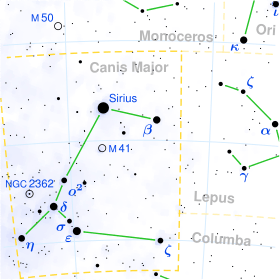 The position of Sirius (circled) | |
| Observation data Epoch J2000.0 Equinox ICRS | |
|---|---|
| Constellation | Canis Major |
| Pronunciation | /ˈsɪriəs/[1] |
| Sirius | |
| Right ascension | 06h 45m 08.91728s[2] |
| Declination | −16° 42′ 58.0171″[2] |
| Apparent magnitude (V) | −1.46[3] |
| A | |
| Right ascension | 06h 45m 08.917s[4] |
| Declination | −16° 42′ 58.02″[4] |
| Apparent magnitude (V) | −1.47[5] |
| B | |
| Right ascension | 06h 45m 09.0s[6] |
| Declination | −16° 43′ 06″[6] |
| Apparent magnitude (V) | 8.44[5] |
| Characteristics | |
| Sirius A | |
| Evolutionary stage | Main sequence |
| Spectral type | A0mA1 Va[7] |
| U−B colour index | −0.05[3] |
| B−V colour index | +0.00[3] |
| Sirius B | |
| Evolutionary stage | White dwarf |
| Spectral type | DA2[5] |
| U−B colour index | −1.04[8] |
| B−V colour index | −0.03[8] |
| Astrometry | |
| Radial velocity (Rv) | −5.50[9] km/s |
| Proper motion (μ) | RA: −546.01[2] mas/yr Dec.: −1223.07[2] mas/yr |
| Parallax (π) | 379.21 ± 1.58[2] mas |
| Distance | 8.60 ± 0.04 ly (2.64 ± 0.01 pc) |
| Sirius A | |
| Absolute magnitude (MV) | +1.42[10] |
| Sirius B | |
| Absolute magnitude (MV) | +11.18[8] |
| Orbit[11] | |
| Primary | α Canis Majoris A |
| Companion | α Canis Majoris B |
| Period (P) | 50.1284 ± 0.0043 yr |
| Semi-major axis (a) | 7.4957 ± 0.0025″ |
| Eccentricity (e) | 0.59142 ± 0.00037 |
| Inclination (i) | 136.336 ± 0.040° |
| Longitude of the node (Ω) | 45.400 ± 0.071° |
| Periastron epoch (T) | 1994.5715 ± 0.0058 |
| Argument of periastron (ω) (secondary) | 149.161 ± 0.075° |
| Details | |
| Sirius A | |
| Mass | 2.063 ± 0.023[11] M☉ |
| Radius | 1.711[12] R☉ |
| Luminosity | 25.4[12] L☉ |
| Surface gravity (log g) | 4.33[13] cgs |
| Temperature | 9,940[13] K |
| Metallicity [Fe/H] | 0.50[14] dex |
| Rotation | 16 km/s[15] |
| Age | 242 ± 5[11] Myr |
| Sirius B | |
| Mass | 1.018 ± 0.011[11] M☉ |
| Radius | 0.0084 ± 3%[16] R☉ |
| Luminosity | 0.056[17] L☉ |
| Surface gravity (log g) | 8.57[16] cgs |
| Temperature | 25,000 ± 200[12] K |
| Age | 228+10 −8[11] Myr |
| Other designations | |
| Sirius B: EGGR 49, WD 0642-166, GCTP 1577.00[23] | |
| Database references | |
| SIMBAD | The system |
| A | |
| B | |
Sirius appears bright because of its intrinsic luminosity and its proximity to the Solar System. At a distance of 2.64 parsecs (8.6 ly), the Sirius system is one of Earth's nearest neighbours. Sirius is gradually moving closer to the Solar System, so it will slightly increase in brightness over the next 60,000 years. After that time, its distance will begin to increase, and it will become fainter, but it will continue to be the brightest star in the Earth's night sky for the next 210,000 years.[25]
Sirius A is about twice as massive as the Sun (M☉) and has an absolute visual magnitude of +1.42. It is 25 times more luminous than the Sun[12] but has a significantly lower luminosity than other bright stars such as Canopus or Rigel. The system is between 200 and 300 million years old.[12] It was originally composed of two bright bluish stars. The more massive of these, Sirius B, consumed its resources and became a red giant before shedding its outer layers and collapsing into its current state as a white dwarf around 120 million years ago.[12]
Sirius is known colloquially as the "Dog Star", reflecting its prominence in its constellation, Canis Major (the Greater Dog).[18] The heliacal rising of Sirius marked the flooding of the Nile in Ancient Egypt and the "dog days" of summer for the ancient Greeks, while to the Polynesians, mostly in the Southern Hemisphere, the star marked winter and was an important reference for their navigation around the Pacific Ocean.

Observational history
| Sirius Spdt in hieroglyphs |
|---|
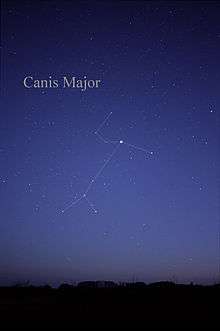
The brightest star in the night sky, Sirius is recorded in some of the earliest astronomical records. Its displacement from the ecliptic causes its heliacal rising to be remarkably regular compared to other stars, with a period of almost exactly 365.25 days holding it constant relative to the solar year. This rising occurs at Cairo on 19 July (Julian), placing it just prior to the onset of the annual flooding of the Nile during antiquity.[26] Owing to the flood's own irregularity, the extreme precision of the star's return made it important to the ancient Egyptians,[26] who worshipped it as the goddess Sopdet (Ancient Egyptian: Spdt, "Triangle";[lower-alpha 1] Greek: Σῶθις, Sō̂this), guarantor of the fertility of their land.[lower-alpha 2] The Egyptian civil calendar was apparently initiated to have its New Year "Mesori" coincide with the appearance of Sirius, although its lack of leap years meant that this congruence only held for four years until its date began to wander backwards through the months. The Egyptians continued to note the times of Sirius's annual return, which may have led them to the discovery of the 1460-year Sothic cycle and influenced the development of the Julian and Alexandrian calendars.
The ancient Greeks observed that the appearance of Sirius heralded the hot and dry summer and feared that it caused plants to wilt, men to weaken, and women to become aroused.[28] Due to its brightness, Sirius would have been seen to twinkle more in the unsettled weather conditions of early summer. To Greek observers, this signified emanations that caused its malignant influence. Anyone suffering its effects was said to be "star-struck" (ἀστροβόλητος, astrobólētos). It was described as "burning" or "flaming" in literature.[29] The season following the star's reappearance came to be known as the "dog days".[30] The inhabitants of the island of Ceos in the Aegean Sea would offer sacrifices to Sirius and Zeus to bring cooling breezes and would await the reappearance of the star in summer. If it rose clear, it would portend good fortune; if it was misty or faint then it foretold (or emanated) pestilence. Coins retrieved from the island from the 3rd century BC feature dogs or stars with emanating rays, highlighting Sirius's importance.[29] The Romans celebrated the heliacal setting of Sirius around April 25, sacrificing a dog, along with incense, wine, and a sheep, to the goddess Robigo so that the star's emanations would not cause wheat rust on wheat crops that year.[31]
Ptolemy of Alexandria mapped the stars in Books VII and VIII of his Almagest, in which he used Sirius as the location for the globe's central meridian. He depicted it as one of six red-coloured stars (see the Colour controversy section below). The other five are class M and K stars, such as Arcturus and Betelgeuse.[32]
Bright stars were important to the ancient Polynesians for navigation of the Pacific Ocean. They also served as latitude markers; the declination of Sirius matches the latitude of the archipelago of Fiji at 17°S and thus passes directly over the islands each night.[33] Sirius served as the body of a "Great Bird" constellation called Manu, with Canopus as the southern wingtip and Procyon the northern wingtip, which divided the Polynesian night sky into two hemispheres.[34] Just as the appearance of Sirius in the morning sky marked summer in Greece, it marked the onset of winter for the Māori, whose name Takurua described both the star and the season. Its culmination at the winter solstice was marked by celebration in Hawaii, where it was known as Ka'ulua, "Queen of Heaven". Many other Polynesian names have been recorded, including Tau-ua in the Marquesas Islands, Rehua in New Zealand, and Ta'urua-fau-papa "Festivity of original high chiefs" and Ta'urua-e-hiti-i-te-tara-te-feiai "Festivity who rises with prayers and religious ceremonies" in Tahiti.[35] The Hawaiian people had many names for Sirius, including Aa ("glowing"),[36] Hoku-kauopae,[37] Kau-ano-meha (also Kaulanomeha), "Standing-alone-and-sacred",[37][38] Hiki-kauelia or Hiki-kauilia (the navigational name), Hiki-kau-lono-meha ("star of solitary Lono", the astrological name),[39] Kaulua (also Kaulua-ihai-mohai, "flower of the heavens"),[40] Hiki-kauelia, Hoku-hoo-kele-waa ("star which causes the canoe to sail", a marine navigation name),[41] and Kaulua-lena ("yellow star").[40] The people of the Society Islands called Sirius variously Taurua-fau-papa, Taurua-nui-te-amo-aha, and Taurua-e-hiti-i-tara-te-feiai. Other names for Sirius included Palolo-mua (Futuna), Mere (Mangaia), Apura (Manihiki), Taku-ua (Marquesas Islands), and Tokiva (Pukapuka).[37] In the cosmology of the Tuamotus, Sirius had various names, including Takurua-te-upuupu,[37] Te Kaha ("coconut fibre"),[42] Te Upuupu,[43] Taranga,[44] and Vero-ma-torutoru ("flaming and diminishing").[45]
The indigenous Boorong people of northwestern Victoria named Sirius as Warepil.[46]
Kinematics
In 1717, Edmond Halley discovered the proper motion of the hitherto presumed "fixed" stars[47] after comparing contemporary astrometric measurements with those from the second century AD given in Ptolemy's Almagest. The bright stars Aldebaran, Arcturus and Sirius were noted to have moved significantly; Sirius had progressed about 30 arc minutes (about the diameter of the Moon) to the southwest.[48]
In 1868, Sirius became the first star to have its velocity measured, the beginning of the study of celestial radial velocities. Sir William Huggins examined the spectrum of the star and observed a red shift. He concluded that Sirius was receding from the Solar System at about 40 km/s.[49][50] Compared to the modern value of −5.5 km/s, this was an overestimate and had the wrong sign; the minus sign (−) means that it is approaching the Sun. It is possible that Huggins did not account for the Earth's orbital velocity, which would cause an error of up to 30 km/s.
Distance
In his 1698 book, Cosmotheoros, Christiaan Huygens estimated the distance to Sirius at 27664 times the distance from the Earth to the Sun (about 0.437 light years, translating to a parallax of roughly 7.5 arcseconds).[51] There were several unsuccessful attempts to measure the parallax of Sirius: by Jacques Cassini (6 seconds); by some astronomers (including Nevil Maskelyne)[52] using Lacaille's observations made at the Cape of Good Hope (4 seconds); by Piazzi (the same amount); using Lacaille's observations made at Paris, more numerous and certain than those made at the Cape (no sensible parallax); by Bessel (no sensible parallax).[53]
Scottish astronomer Thomas Henderson used his observations made in 1832–1833 and South African astronomer Thomas Maclear's observations made in 1836–1837, to determine that the value of the parallax was 0.23 arcseconds, and error of the parallax was estimated not to exceed a quarter of a second, or as Henderson wrote in 1839, "On the whole we may conclude that the parallax of Sirius is not greater than half a second in space; and that it is probably much less."[54] Astronomers adopted a value of 0.25 arcseconds for much of the 19th century.[55] It is now known to have a parallax of 0.3792 ± 0.0016 arcseconds and therefore a distance of 1/0.3792 ≅ 2.637 parsecs, showing Henderson's estimate to be accurate.
Discovery of Sirius B
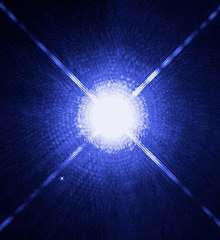
In 1844, the German astronomer Friedrich Bessel deduced from changes in the proper motion of Sirius that it had an unseen companion.[56] On January 31, 1862, American telescope-maker and astronomer Alvan Graham Clark first observed the faint companion, which is now called Sirius B, or affectionately "the Pup".[57] This happened during testing of an 18.5-inch (470 mm) aperture great refractor telescope for Dearborn Observatory, which was one of the largest refracting telescope lenses in existence at the time, and the largest telescope in the United States.[58] Sirius B's sighting was confirmed on March 8 with smaller telescopes.[59]
The visible star is now sometimes known as Sirius A. Since 1894, some apparent orbital irregularities in the Sirius system have been observed, suggesting a third very small companion star, but this has never been confirmed. The best fit to the data indicates a six-year orbit around Sirius A and a mass of 0.06 M☉. This star would be five to ten magnitudes fainter than the white dwarf Sirius B, which would make it difficult to observe.[60] Observations published in 2008 were unable to detect either a third star or a planet. An apparent "third star" observed in the 1920s is now believed to be a background object.[61]
In 1915, Walter Sydney Adams, using a 60-inch (1.5 m) reflector at Mount Wilson Observatory, observed the spectrum of Sirius B and determined that it was a faint whitish star.[62] This led astronomers to conclude that it was a white dwarf, the second to be discovered.[63] The diameter of Sirius A was first measured by Robert Hanbury Brown and Richard Q. Twiss in 1959 at Jodrell Bank using their stellar intensity interferometer.[64] In 2005, using the Hubble Space Telescope, astronomers determined that Sirius B has nearly the diameter of the Earth, 12,000 kilometres (7,500 mi), with a mass 102% of the Sun's.[65]
Colour controversy
Around the year 150 CE, the Greek astronomer of the Roman period, Claudius Ptolemy, described Sirius as reddish, along with five other stars, Betelgeuse, Antares, Aldebaran, Arcturus and Pollux, all of which are of orange or red hue.[66] The discrepancy was first noted by amateur astronomer Thomas Barker, squire of Lyndon Hall in Rutland, who prepared a paper and spoke at a meeting of the Royal Society in London in 1760.[67] The existence of other stars changing in brightness gave credibility to the idea that some may change in colour too; Sir John Herschel noted this in 1839, possibly influenced by witnessing Eta Carinae two years earlier.[68] Thomas Jefferson Jackson See resurrected discussion on red Sirius with the publication of several papers in 1892, and a final summary in 1926.[69] He cited not only Ptolemy but also the poet Aratus, the orator Cicero, and general Germanicus as calling the star red, though acknowledging that none of the latter three authors were astronomers, the last two merely translating Aratus's poem Phaenomena.[70] Seneca had described Sirius as being of a deeper red than Mars.[71] Not all ancient observers saw Sirius as red. The 1st-century poet Marcus Manilius described it as "sea-blue", as did the 4th century Avienus.[72] It was the standard white star in ancient China, and multiple records from the 2nd century BCE up to the 7th century CE all describe Sirius as white.[73][74]
In 1985, German astronomers Wolfhard Schlosser and Werner Bergmann published an account of an 8th-century Lombardic manuscript, which contains De cursu stellarum ratio by St. Gregory of Tours. The Latin text taught readers how to determine the times of nighttime prayers from positions of the stars, and Sirius is described within as rubeola – "reddish". The authors proposed this was further evidence Sirius B had been a red giant at the time.[75] Other scholars replied that it was likely St. Gregory had been referring to Arcturus.[76][77]
The possibility that stellar evolution of either Sirius A or Sirius B could be responsible for this discrepancy has been rejected by astronomers on the grounds that the timescale of thousands of years is much too short and that there is no sign of the nebulosity in the system that would be expected had such a change taken place.[71] An interaction with a third star, to date undiscovered, has also been proposed as a possibility for a red appearance.[78] Alternative explanations are either that the description as red is a poetic metaphor for ill fortune, or that the dramatic scintillations of the star when rising left the viewer with the impression that it was red. To the naked eye, it often appears to be flashing with red, white, and blue hues when near the horizon.[71]
Observation
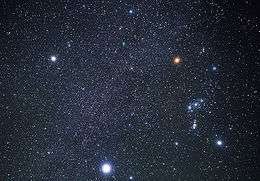
With an apparent magnitude of −1.46, Sirius is the brightest star in the night sky, almost twice as bright as the second-brightest star, Canopus.[79] From Earth, Sirius always appears dimmer than Jupiter and Venus, as well as Mercury and Mars at certain times.[80] Sirius is visible from almost everywhere on Earth, except latitudes north of 73° N, and it does not rise very high when viewed from some northern cities (reaching only 13° above the horizon from Saint Petersburg).[81] Due to its declination of roughly −17°, Sirius is a circumpolar star from latitudes south of 73° S. From the Southern Hemisphere in early July, Sirius can be seen in both the evening where it sets after the Sun and in the morning where it rises before the Sun.[82]
Sirius, along with Procyon and Betelgeuse, forms one of the three vertices of the Winter Triangle to observers in the Northern Hemisphere.[83]
Due to precession (and slight proper motion), Sirius will move further south in the future. Starting around the year 9000, Sirius will no longer be visible from northern and central Europe, and in 14,000 its declination will be −67° and thus it will be circumpolar throughout South Africa and in most parts of Australia.
Sirius can be observed in daylight with the naked eye under the right conditions. Ideally, the sky should be very clear, with the observer at a high altitude, the star passing overhead, and the Sun low on the horizon.[84] These observing conditions are more easily met in the Southern Hemisphere, due to the southerly declination of Sirius.
The orbital motion of the Sirius binary system brings the two stars to a minimum angular separation of 3 arcseconds and a maximum of 11 arcseconds. At the closest approach, it is an observational challenge to distinguish the white dwarf from its more luminous companion, requiring a telescope with at least 300 mm (12 in) aperture and excellent seeing conditions. After a periastron occurred in 1994[lower-alpha 3], the pair moved apart, making them easier to separate with a telescope.[85] Apoastron occurred in 2019[lower-alpha 4], but from the Earth's vantage point, the greatest observational separation will occur in 2023, with an angular separation of 11.333".[86]
At a distance of 2.6 parsecs (8.6 ly), the Sirius system contains two of the eight nearest stars to the Sun, and it is the fifth closest stellar system to the Sun.[87] This proximity is the main reason for its brightness, as with other near stars such as Alpha Centauri and in contrast to distant, highly luminous supergiants such as Canopus, Rigel or Betelgeuse.[88] It is still around 25 times more luminous than the Sun.[12] The closest large neighbouring star to Sirius is Procyon, 1.61 parsecs (5.24 ly) away.[89] The Voyager 2 spacecraft, launched in 1977 to study the four giant planets in the Solar System, is expected to pass within 4.3 light-years (1.3 pc) of Sirius in approximately 296,000 years.[90]
Stellar system

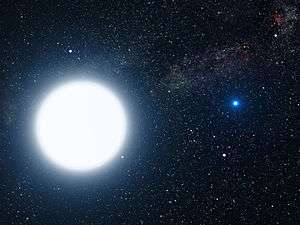
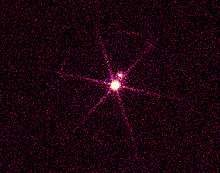
Sirius is a binary star system consisting of two white stars orbiting each other with a separation of about 20 AU[lower-alpha 5] (roughly the distance between the Sun and Uranus) and a period of 50.1 years. The brighter component, termed Sirius A, is a main-sequence star of spectral type early A, with an estimated surface temperature of 9,940 K.[13] Its companion, Sirius B, is a star that has already evolved off the main sequence and become a white dwarf. Currently 10,000 times less luminous in the visual spectrum, Sirius B was once the more massive of the two.[91] The age of the system has been estimated at around 230 million years. Early in its life, it is thought to have been two bluish-white stars orbiting each other in an elliptical orbit every 9.1 years.[91] The system emits a higher than expected level of infrared radiation, as measured by IRAS space-based observatory. This might be an indication of dust in the system, which is considered somewhat unusual for a binary star.[89][92] The Chandra X-ray Observatory image shows Sirius B outshining its partner as an X-ray source.[93]
In 2015, Vigan and colleagues used the VLT Survey Telescope to search for evidence of substellar companions, and were able to rule out the presence of giant planets 11 times more massive than Jupiter at 0.5 AU distance from Sirius A, 6–7 times the mass of Jupiter at 1–2 AU distance, and down to around 4 times the mass of Jupiter at 10 AU distance.[94]
Sirius A
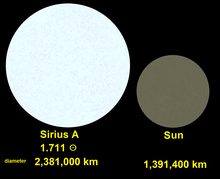
Sirius A has a mass of 2 M☉.[11][12][95] The radius of this star has been measured by an astronomical interferometer, giving an estimated angular diameter of 5.936±0.016 mas. The projected rotational velocity is a relatively low 16 km/s,[15] which does not produce any significant flattening of its disk.[96] This is at marked variance with the similar-sized Vega, which rotates at a much faster 274 km/s and bulges prominently around its equator.[97] A weak magnetic field has been detected on the surface of Sirius A.[98]
Stellar models suggest that the star formed during the collapsing of a molecular cloud and that, after 10 million years, its internal energy generation was derived entirely from nuclear reactions. The core became convective and used the CNO cycle for energy generation.[96] It is predicted that Sirius A will have completely exhausted the store of hydrogen at its core within a billion (109) years of its formation. At this point, it will pass through a red giant stage, then settle down to become a white dwarf.
Sirius A is classed as an Am star because the spectrum shows deep metallic absorption lines,[99] indicating an enhancement in elements heavier than helium, such as iron.[89][96] The spectral type has been reported as A0mA1 Va, which indicates that it would be classified as A1 from hydrogen and helium lines, but A0 from the metallic lines that cause it to be grouped with the Am stars.[7] When compared to the Sun, the proportion of iron in the atmosphere of Sirius A relative to hydrogen is given by ,[14] meaning iron is 316% as abundant as in the Sun's atmosphere. The high surface content of metallic elements is unlikely to be true of the entire star; rather the iron-peak and heavy metals are radiatively levitated towards the surface.[96]
Sirius B
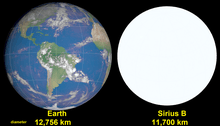
Sirius B is one of the most massive white dwarfs known. With a mass of 1.02 M☉, it is almost double the 0.5–0.6 M☉ average. This mass is packed into a volume roughly equal to the Earth's.[65] The current surface temperature is 25,200 K.[12] Because there is no internal heat source, Sirius B will steadily cool as the remaining heat is radiated into space over more than two billion years.[100]
A white dwarf forms after a star has evolved from the main sequence and then passed through a red giant stage. This occurred when Sirius B was less than half its current age, around 120 million years ago. The original star had an estimated 5 M☉[12] and was a B-type star (roughly B4–5)[101][102] when it was still on the main sequence. While it passed through the red giant stage, Sirius B may have enriched the metallicity of its companion.
This star is primarily composed of a carbon–oxygen mixture that was generated by helium fusion in the progenitor star.[12] This is overlaid by an envelope of lighter elements, with the materials segregated by mass because of the high surface gravity.[103] The outer atmosphere of Sirius B is now almost pure hydrogen—the element with the lowest mass—and no other elements are seen in its spectrum.[104]
Apparent third star
Since 1894, irregularities have been observed in the orbits of Sirius A and B with an apparent periodicity of 6–6.4 years. A 1995 study concluded that such a companion likely exists, with a mass of roughly 0.05 solar masses- a small red dwarf or large brown dwarf, with an apparent magnitude of >15, and less than 3 arcseconds from Sirius A.[60]
More recent (and accurate) astrometric observations by the Hubble Space Telescope ruled out the existence of such a Sirius C entirely. The 1995 study predicted an astrometric movement of roughly 90 mas (0.09 arcseconds), but Hubble was unable to detect any location anomaly to an accuracy of 5 mas (0.005 arcsec). This ruled out any objects orbiting Sirius A with more than 0.033 solar masses orbiting in 0.5 years, and 0.014 in 2 years. The study was also able to rule out any companions to Sirius B with more than 0.024 solar masses orbiting in 0.5 years, and 0.0095 orbiting in 1.8 years. Effectively, there are almost certainly no additional bodies in the Sirius system larger than a small brown dwarf or large exoplanet.[105]
Star cluster membership
In 1909, Ejnar Hertzsprung was the first to suggest that Sirius was a member of the Ursa Major Moving Group, based on his observations of the system's movements across the sky. The Ursa Major Group is a set of 220 stars that share a common motion through space. It was once a member of an open cluster, but has since become gravitationally unbound from the cluster.[106] Analyses in 2003 and 2005 found Sirius's membership in the group to be questionable: the Ursa Major Group has an estimated age of 500 ± 100 million years, whereas Sirius, with metallicity similar to the Sun's, has an age that is only half this, making it too young to belong to the group.[12][107][108] Sirius may instead be a member of the proposed Sirius Supercluster, along with other scattered stars such as Beta Aurigae, Alpha Coronae Borealis, Beta Crateris, Beta Eridani and Beta Serpentis.[109] This would be one of three large clusters located within 500 light-years (150 pc) of the Sun. The other two are the Hyades and the Pleiades, and each of these clusters consists of hundreds of stars.[110]
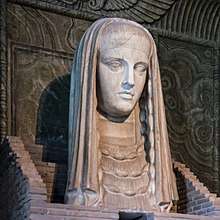
Gaia 1
In 2017, a massive star cluster was discovered only 10′ from Sirius. It was discovered during a statistical analysis of Gaia data. The cluster is over a thousand times further away from us than the star system.[111]
Etymology and cultural significance
The proper name "Sirius" comes from the Latin Sīrius, from the Ancient Greek Σείριος (Seirios, "glowing" or "scorcher").[112] The Greek word itself may have been imported from elsewhere before the Archaic period,[113] one authority suggesting a link with the Egyptian god Osiris.[114] The name's earliest recorded use dates from the 7th century BC in Hesiod's poetic work Works and Days.[113] In 2016, the International Astronomical Union organized a Working Group on Star Names (WGSN)[115] to catalog and standardize proper names for stars. The WGSN's first bulletin of July 2016[116] included a table of the first two batches of names approved by the WGSN; which included Sirius for the star α Canis Majoris A. It is now so entered in the IAU Catalog of Star Names.[117]
Sirius has over 50 other designations and names attached to it.[79] In Geoffrey Chaucer's essay Treatise on the Astrolabe, it bears the name Alhabor and is depicted by a hound's head. This name is widely used on medieval astrolabes from Western Europe.[19] In Sanskrit it is known as Mrgavyadha "deer hunter", or Lubdhaka "hunter". As Mrgavyadha, the star represents Rudra (Shiva).[118][119] The star is referred as Makarajyoti in Malayalam and has religious significance to the pilgrim center Sabarimala.[120] In Scandinavia, the star has been known as Lokabrenna ("burning done by Loki", or "Loki's torch").[121] In the astrology of the Middle Ages, Sirius was a Behenian fixed star,[122] associated with beryl and juniper. Its astrological symbol ![]()
Many cultures have historically attached special significance to Sirius, particularly in relation to dogs. It is often colloquially called the "Dog Star" as the brightest star of Canis Major, the "Great Dog" constellation. Canis Major was classically depicted as Orion's dog. The Ancient Greeks thought that Sirius's emanations could affect dogs adversely, making them behave abnormally during the "dog days", the hottest days of the summer. The Romans knew these days as dies caniculares, and the star Sirius was called Canicula, "little dog". The excessive panting of dogs in hot weather was thought to place them at risk of desiccation and disease. In extreme cases, a foaming dog might have rabies, which could infect and kill humans they had bitten.[29] Homer, in the Iliad, describes the approach of Achilles toward Troy in these words:[124]
Sirius rises late in the dark, liquid sky
On summer nights, star of stars,
Orion's Dog they call it, brightest
Of all, but an evil portent, bringing heat
And fevers to suffering humanity.
In Iranian mythology, especially in Persian mythology and in Zoroastrianism, the ancient religion of Persia, Sirius appears as Tishtrya and is revered as the rain-maker divinity (Tishtar of New Persian poetry). Beside passages in the sacred texts of the Avesta, the Avestan language Tishtrya followed by the version Tir in Middle and New Persian is also depicted in the Persian epic Shahnameh of Ferdowsi. Due to the concept of the yazatas, powers which are "worthy of worship", Tishtrya is a divinity of rain and fertility and an antagonist of apaosha, the demon of drought. In this struggle, Tishtrya is depicted as a white horse.[125][126][127][128]
In Chinese astronomy Sirius is known as the star of the "celestial wolf" (Chinese and Japanese: 天狼 Chinese romanization: Tiānláng; Japanese romanization: Tenrō;[129]) in the Mansion of Jǐng (井宿). Many nations among the indigenous peoples of North America also associated Sirius with canines; the Seri and Tohono O'odham of the southwest note the star as a dog that follows mountain sheep, while the Blackfoot called it "Dog-face". The Cherokee paired Sirius with Antares as a dog-star guardian of either end of the "Path of Souls". The Pawnee of Nebraska had several associations; the Wolf (Skidi) tribe knew it as the "Wolf Star", while other branches knew it as the "Coyote Star". Further north, the Alaskan Inuit of the Bering Strait called it "Moon Dog".[130]
Several cultures also associated the star with a bow and arrows. The ancient Chinese visualized a large bow and arrow across the southern sky, formed by the constellations of Puppis and Canis Major. In this, the arrow tip is pointed at the wolf Sirius. A similar association is depicted at the Temple of Hathor in Dendera, where the goddess Satet has drawn her arrow at Hathor (Sirius). Known as "Tir", the star was portrayed as the arrow itself in later Persian culture.[131]
Sirius is mentioned in Surah, An-Najm ("The Star"), of the Qur'an, where it is given the name الشِّعْرَى (transliteration: aš-ši‘rā or ash-shira; the leader).[132] The verse is: "وأنَّهُ هُوَ رَبُّ الشِّعْرَى", "That He is the Lord of Sirius (the Mighty Star)." (An-Najm:49)[133] Ibn Kathir said in his commentary "that it is the bright star, named Mirzam Al-Jawza' (Sirius), which a group of Arabs used to worship".[134] The alternate name Aschere, used by Johann Bayer, is derived from this.[18]
In theosophy, it is believed the Seven Stars of the Pleiades transmit the spiritual energy of the Seven Rays from the Galactic Logos to the Seven Stars of the Great Bear, then to Sirius. From there is it sent via the Sun to the god of Earth (Sanat Kumara), and finally through the seven Masters of the Seven Rays to the human race.[135]
Dogon
The Dogon people are an ethnic group in Mali, West Africa, reported by some researchers to have traditional astronomical knowledge about Sirius that would normally be considered impossible without the use of telescopes. According to Marcel Griaule, they knew about the fifty-year orbital period of Sirius and its companion prior to western astronomers.[136][137] In his pseudoarcheology book The Sirius Mystery, Robert Temple claimed that the Dogon people have a tradition of contact with intelligent extraterrestrial beings from Sirius.[138]

Doubts have been raised about the validity of Griaule and Dieterlein's work.[141][142] In 1991, anthropologist Walter van Beek concluded about the Dogon, "Though they do speak about sigu tolo [which is what Griaule claimed the Dogon called Sirius] they disagree completely with each other as to which star is meant; for some it is an invisible star that should rise to announce the sigu [festival], for another it is Venus that, through a different position, appears as sigu tolo. All agree, however, that they learned about the star from Griaule."[143]
Noah Brosch claims that the cultural transfer of relatively modern astronomical information could have taken place in 1893, when a French expedition arrived in Central West Africa to observe the total eclipse on April 16.[144]
Serer religion
In the religion of the Serer people of Senegal, the Gambia and Mauritania, Sirius is called Yoonir from the Serer language (and some of the Cangin language speakers, who are all ethnically Serers). The star Sirius is one of the most important and sacred stars in Serer religious cosmology and symbolism. The Serer high priests and priestesses (Saltigues, the hereditary "rain priests"[145]) chart Yoonir in order to forecast rainfall and enable Serer farmers to start planting seeds. In Serer religious cosmology, it is the symbol of the universe.[139][140]
Modern significance
Sirius is a frequent subject of science fiction,[146] and has been the subject of poetry.[147] Dante and John Milton reference the star, and it is the "powerful western fallen star" of Walt Whitman's "Then Lilacs Last in the Dooryard Bloom'd", while Tennyson's poem The Princess describes the star's scintillation:[148]
...the fiery Sirius alters hue
And bickers into red and emerald.
Other modern references:
- Plans for using solar sail propulsion for interstellar travel have targeted Sirius as the star system fastest to arrive at from Earth.[149] While Alpha Centauri and others are closer, the brightness of Sirius provides the best braking power to arrive with the least travel time.
- Sirius is featured on the coat of arms of Macquarie University and is the name of its alumnae journal.[150]
- The name of the North American satellite radio company Satellite CD Radio, Inc. was changed to Sirius Satellite Radio in November 1999, being named after "the brightest star in the night sky".[151]
- Composer Karlheinz Stockhausen, who wrote a piece called Sirius, has been claimed to have said on several occasions that he came from a planet in the Sirius system.[152][153] To Stockhausen, Sirius stood for "the place where music is the highest of vibrations" and where music had been developed in the most perfect way.[154]
- The Sirius Patrol, an elite Danish arctic command unit that conducts long-range reconnaissance patrolling, and enforces Danish sovereignty in the Arctic wilderness of northern and eastern Greenland, with the help of primarily dog sleds, is named after the star.
- Astronomer Noah Brosch has speculated that the name of the character Sirius Black from the Harry Potter stories, who has a unique ability to transform into a black dog, might have been inspired by "Sirius B".[147]
- Sirius is one of the 27 stars on the flag of Brazil, where it represents the state of Mato Grosso.[155]
- The Swedish football team IK Sirius from Uppsala, who currently plays in the top tier Allsvenskan, is named after the star system.[156]
Vehicles:
- Seven ships of Great Britain's Royal Navy have been called HMS Sirius since the 18th century, with the first being the flagship of the First Fleet to Australia in 1788.[157]
- The Royal Australian Navy subsequently named a vessel HMAS Sirius in honor of the flagship.[158]
- American vessels include the USNS Sirius and a monoplane Lockheed Model 8 Sirius, the first of which was flown by Charles Lindbergh.[159] The name was also adopted by Mitsubishi Motors for the Mitsubishi Sirius engine in 1980.[160]
Notes
- Compare the meaning of the Egyptian name with Sirius's completion of the Winter Triangle asterism, joining the other two brightest stars of the northern winter sky, Betelgeuse and Procyon.
- As Sirius is visible together with the constellation of Orion, the Egyptians worshipped Orion as the god Sah, the husband of Sopdet, with whom she had a son, the sky god Sopdu. The goddess Sopdet was later syncretized with the goddess Isis, Sah was linked with Osiris, and Sopdu was linked with Horus. The joining of Sopdet with Isis would allow Plutarch to state that "The soul of Isis is called Dog by the Greeks", meaning Sirius worshipped as Isis-Sopdet by Egyptians was named the Dog by the Greeks and Romans. The 70-day period of the absence of Sirius from the sky was understood as the passing of Sopdet-Isis and Sah-Osiris through the Egyptian underworld.[27]
- Two full 50.09-year orbits following the periastron epoch of 1894.13 gives a date of 1994.31.
- Two and one-half 50.09-year orbits following the periastron epoch of 1894.13 gives a date of 2019.34.
- Semi-major axis in AU = semimajor axis in seconds / parallax = 7.56″ / 0.37921 = 19.8 AU; as the eccentricity is 0.6, the distance fluctuates between 40% and 160% of that, roughly from 8 AU to 32 AU.
References
Citations
- "Sirius". Dictionary.com Unabridged (v 1.1). Random House, Inc. Retrieved 6 April 2008.
- van Leeuwen, F. (November 2007), "Validation of the new Hipparcos reduction", Astronomy and Astrophysics, 474 (2): 653–664, arXiv:0708.1752, Bibcode:2007A&A...474..653V, doi:10.1051/0004-6361:20078357
- Hoffleit, D.; Warren Jr., W. H. (1991). "Entry for HR 2491". Bright Star Catalogue, 5th Revised Ed. (Preliminary Version). CDS. ID V/50.
- Fabricius, C.; Høg, E.; Makarov, V. V.; Mason, B. D.; Wycoff, G. L.; Urban, S. E. (2002). "The Tycho double star catalogue". Astronomy and Astrophysics. 384: 180–189. Bibcode:2002A&A...384..180F. doi:10.1051/0004-6361:20011822.
- Holberg, J. B.; Oswalt, T. D.; Sion, E. M.; Barstow, M. A.; Burleigh, M. R. (2013). "Where are all the Sirius-like binary systems?". Monthly Notices of the Royal Astronomical Society. 435 (3): 2077. arXiv:1307.8047. Bibcode:2013MNRAS.435.2077H. doi:10.1093/mnras/stt1433.
- Gianninas, A.; Bergeron, P.; Ruiz, M. T. (2011). "A Spectroscopic Survey and Analysis of Bright, Hydrogen-rich White Dwarfs". The Astrophysical Journal. 743 (2): 138. arXiv:1109.3171. Bibcode:2011ApJ...743..138G. doi:10.1088/0004-637X/743/2/138.
- Gray, R. O.; Corbally, C. J.; Garrison, R. F.; McFadden, M T.; Robinson, P. E. (2003). "Contributions to the Nearby Stars (NStars) Project: Spectroscopy of Stars Earlier than M0 within 40 Parsecs: The Northern Sample. I." Astronomical Journal. 126 (4): 2048–2059. arXiv:astro-ph/0308182. Bibcode:2003AJ....126.2048G. doi:10.1086/378365.
- McCook, G. P.; Sion, E. M. "Entry for WD 0642-166". A Catalogue of Spectroscopically Identified White Dwarfs (August 2006 version). CDS. ID III/235A.)
- Gontcharov, G. A. (2006). "Pulkovo Compilation of Radial Velocities for 35 495 Hipparcos stars in a common system". Astronomy Letters. 32 (11): 759–771. arXiv:1606.08053. Bibcode:2006AstL...32..759G. doi:10.1134/S1063773706110065. ISSN 1063-7737.
- Brosch, Noah (2008). "Modern optical measurements". Sirius Matters. Astrophysics and Space Science Library. 354. pp. 89–117. doi:10.1007/978-1-4020-8319-8_5. ISBN 978-1-4020-8318-1. ISSN 0067-0057.
- Bond, Howard E.; Schaefer, Gail H.; Gilliland, Ronald L.; Holberg, Jay B.; Mason, Brian D.; Lindenblad, Irving W.; Seitz-Mcleese, Miranda; Arnett, W. David; Demarque, Pierre; Spada, Federico; Young, Patrick A.; Barstow, Martin A.; Burleigh, Matthew R.; Gudehus, Donald (2017). "The Sirius System and Its Astrophysical Puzzles: Hubble Space Telescope and Ground-based Astrometry". The Astrophysical Journal. 840 (2): 70. arXiv:1703.10625. Bibcode:2017ApJ...840...70B. doi:10.3847/1538-4357/aa6af8.
- Liebert, J.; Young, P. A.; Arnett, D.; Holberg, J. B.; Williams, K. A. (2005). "The Age and Progenitor Mass of Sirius B". The Astrophysical Journal. 630 (1): L69–L72. arXiv:astro-ph/0507523. Bibcode:2005ApJ...630L..69L. doi:10.1086/462419.CS1 maint: ref=harv (link)
- Adelman, Saul J. (July 8–13, 2004). "The Physical Properties of normal A stars". Proceedings of the International Astronomical Union. Poprad, Slovakia: Cambridge University Press. pp. 1–11. Bibcode:2004IAUS..224....1A. doi:10.1017/S1743921304004314.
- Qiu, H. M.; Zhao, G.; Chen, Y. Q.; Li, Z. W. (2001). "The Abundance Patterns of Sirius and Vega". The Astrophysical Journal. 548 (2): 953–965. Bibcode:2001ApJ...548..953Q. doi:10.1086/319000.CS1 maint: ref=harv (link)
- Royer, F.; Gerbaldi, M.; Faraggiana, R.; Gómez, A. E. (2002). "Rotational velocities of A-type stars. I. Measurement of v sin i in the southern hemisphere". Astronomy and Astrophysics. 381 (1): 105–121. arXiv:astro-ph/0110490. Bibcode:2002A&A...381..105R. doi:10.1051/0004-6361:20011422.CS1 maint: ref=harv (link)
- Holberg, J. B.; Barstow, M. A.; Bruhweiler, F. C.; Cruise, A. M.; Penny, A. J. (1998). "Sirius B: A New, More Accurate View". The Astrophysical Journal. 497 (2): 935–942. Bibcode:1998ApJ...497..935H. doi:10.1086/305489.CS1 maint: ref=harv (link)
- Sweeney, M. A. (1976). "Cooling times, luminosity functions and progenitor masses of degenerate dwarfs". Astronomy and Astrophysics. 49: 375. Bibcode:1976A&A....49..375S.
- Hinckley, Richard Allen (1899). Star-names and Their Meanings. New York: G. E. Stechert. pp. 117–25.
- Gingerich, O. (1987). "Zoomorphic Astrolabes and the Introduction of Arabic Star Names into Europe". Annals of the New York Academy of Sciences. 500 (1): 89–104. Bibcode:1987NYASA.500...89G. doi:10.1111/j.1749-6632.1987.tb37197.x.
- Singh, Nagendra Kumar (2002). Encyclopaedia of Hinduism, A Continuing Series. Anmol Publications PVT. LTD. p. 794. ISBN 81-7488-168-9.
- Spahn, Mark; Hadamitzky, Wolfgang; Fujie-Winter, Kimiko (1996). The Kanji dictionary. Tuttle language library. Tuttle Publishing. p. 724. ISBN 0-8048-2058-9.
- "Sirius A". SIMBAD Astronomical Database. Centre de Données astronomiques de Strasbourg. Retrieved 20 October 2007.
- "Sirius B". SIMBAD Astronomical Database. Centre de Données astronomiques de Strasbourg. Retrieved 23 October 2007.
- Schaaf, Fred (2008). The Brightest Stars. Hoboken, New Jersey: John Wiley & Sons. p. 94. ISBN 978-0-471-70410-2.
- Sky and Telescope, April 1998 (p60), based on computations from Hipparcos data.
- Wendorf, Fred; Schild, Romuald (2001). Holocene Settlement of the Egyptian Sahara: Volume 1, The Archaeology of Nabta Plain (Google Book Search preview). Springer. p. 500. ISBN 0-306-46612-0.
- Holberg 2007, pp. 4–5
- Holberg 2007, p. 19
- Holberg 2007, p. 20
- Holberg 2007, pp. 16–17
- Ovid. Fasti IV, lines 901–942.
- Holberg 2007, p. 32
- Holberg 2007, p. 25
- Holberg 2007, pp. 25–26
- Henry, Teuira (1907). "Tahitian Astronomy: Birth of Heavenly Bodies". The Journal of the Polynesian Society. 16 (2): 101–04. JSTOR 20700813.
- Makemson 1941, p. 198.
- Makemson 1941, p. 280.
- Makemson 1941, p. 218.
- Makemson 1941, p. 207.
- Makemson 1941, p. 219.
- Makemson 1941, p. 209.
- Makemson 1941, p. 214.
- Makemson 1941, p. 265.
- Makemson 1941, p. 257.
- Makemson 1941, p. 266.
- Hamacher, Duane W.; Frew, David J. (2010). "An Aboriginal Australian Record of the Great Eruption of Eta Carinae". Journal of Astronomical History & Heritage. 13 (3): 220–34. arXiv:1010.4610. Bibcode:2010JAHH...13..220H.
- Aitken, R. G. (1942). "Edmund Halley and Stellar Proper Motions". Astronomical Society of the Pacific Leaflets. 4 (164): 103–112. Bibcode:1942ASPL....4..103A.CS1 maint: ref=harv (link)
- Holberg 2007, pp. 41–42
- Daintith, John; Mitchell, Sarah; Tootill, Elizabeth; Gjertsen, D. (1994). Biographical Encyclopedia of Scientists. CRC Press. p. 442. ISBN 0-7503-0287-9.
- Huggins, W. (1868). "Further observations on the spectra of some of the stars and nebulae, with an attempt to determine therefrom whether these bodies are moving towards or from the Earth, also observations on the spectra of the Sun and of Comet II". Philosophical Transactions of the Royal Society of London. 158: 529–564. Bibcode:1868RSPT..158..529H. doi:10.1098/rstl.1868.0022.CS1 maint: ref=harv (link)
- Huygens, Christiaan, ΚΟΣΜΟΘΕΩΡΟΣ, sive De terris cœlestibus (The Hague, 1698), p. 137.
- Maskelyne, Nevil (1761). "A Proposal for Discovering the Annual Parallax of Sirius; by the Rev. Nevil Maskelyne, a. M. Fellow of Trinity College, Cambridge, and F. R. S." Philosophical Transactions of the Royal Society. 51 (2): 889–895. Bibcode:1759RSPT...51..889M. doi:10.1098/rstl.1759.0080. Google Books id: — page 889
- Henderson, T. (1840). "On the Parallax of Sirius". Memoirs of the Royal Astronomical Society. 11: 239. Bibcode:1840MmRAS..11..239H.
- Henderson, T. (1839). "On the parallax of Sirius". Monthly Notices of the Royal Astronomical Society. 5 (2): 5–7. Bibcode:1839MNRAS...5....5H. doi:10.1093/mnras/5.2.5.
- Holberg 2007, p. 45
- Bessel, F. W. (December 1844). "On the Variations of the Proper Motions of Procyon and Sirius". Monthly Notices of the Royal Astronomical Society. 6 (11): 136–141. Bibcode:1844MNRAS...6R.136B. doi:10.1093/mnras/6.11.136a.CS1 maint: ref=harv (link)
- Flammarion, Camille (August 1877). "The Companion of Sirius". The Astronomical Register. 15 (176): 186–189. Bibcode:1877AReg...15..186F.CS1 maint: ref=harv (link)
- Craig, John; Gravatt, William; Slater, Thomas; Rennie, George. "The Craig Telescope". craig-telescope.co.uk. Retrieved 3 January 2011.
- Appletons' annual cyclopaedia and register of important events of the year: 1862. New York: D. Appleton & Company. 1863. p. 176.
- Benest, D.; Duvent, J. L. (July 1995). "Is Sirius a triple star?". Astronomy and Astrophysics. 299: 621–628. Bibcode:1995A&A...299..621B.CS1 maint: ref=harv (link) – For the instability of an orbit around Sirius B, see § 3.2.
- Bonnet-Bidaud, J. M.; Pantin, E. (October 2008). "ADONIS high contrast infrared imaging of Sirius-B". Astronomy and Astrophysics. 489 (2): 651–655. arXiv:0809.4871. Bibcode:2008A&A...489..651B. doi:10.1051/0004-6361:20078937.CS1 maint: ref=harv (link)
- Adams, W. S. (December 1915). "The Spectrum of the Companion of Sirius". Publications of the Astronomical Society of the Pacific. 27 (161): 236–237. Bibcode:1915PASP...27..236A. doi:10.1086/122440.CS1 maint: ref=harv (link)
- Holberg, J. B. (2005). "How Degenerate Stars Came to be Known as White Dwarfs". Bulletin of the American Astronomical Society. 37 (2): 1503. Bibcode:2005AAS...20720501H.CS1 maint: ref=harv (link)
- Brown, R. Hanbury; Twiss, R. Q. (1958). "Interferometry of the Intensity Fluctuations in Light. IV. A Test of an Intensity Interferometer on Sirius A". Proceedings of the Royal Society of London. 248 (1253): 222–237. Bibcode:1958RSPSA.248..222B. doi:10.1098/rspa.1958.0240.CS1 maint: ref=harv (link)
- Barstow, M. A.; Bond, Howard E.; Holberg, J. B.; Burleigh, M. R.; Hubeny, I.; Koester, D. (2005). "Hubble Space Telescope spectroscopy of the Balmer lines in Sirius B". Monthly Notices of the Royal Astronomical Society. 362 (4): 1134–1142. arXiv:astro-ph/0506600. Bibcode:2005MNRAS.362.1134B. doi:10.1111/j.1365-2966.2005.09359.x.CS1 maint: ref=harv (link)
- Holberg 2007, p. 157
- Ceragioli, R. C. (1995). "The Debate Concerning 'Red' Sirius". Journal for the History of Astronomy. 26 (3): 187–226. Bibcode:1995JHA....26..187C. doi:10.1177/002182869502600301.CS1 maint: ref=harv (link)
- Holberg 2007, p. 158
- Holberg 2007, p. 161
- Holberg 2007, p. 162
- Whittet, D. C. B. (1999). "A physical interpretation of the 'red Sirius' anomaly". Monthly Notices of the Royal Astronomical Society. 310 (2): 355–359. Bibcode:1999MNRAS.310..355W. doi:10.1046/j.1365-8711.1999.02975.x.CS1 maint: ref=harv (link)
- Holberg 2007, p. 163
- 江晓原 (1992). 中国古籍中天狼星颜色之记载. 天文学报 (in Chinese). 33 (4).CS1 maint: ref=harv (link)
- Jiang, Xiao-Yuan (April 1993). "The colour of Sirius as recorded in ancient Chinese texts". Chinese Astronomy and Astrophysics. 17 (2): 223–228. Bibcode:1993ChA&A..17..223J. doi:10.1016/0275-1062(93)90073-X.CS1 maint: ref=harv (link)
- Schlosser, W.; Bergmann, W. (November 1985). "An early-medieval account on the red colour of Sirius and its astrophysical implications". Nature. 318 (6041): 45–46. Bibcode:1985Natur.318...45S. doi:10.1038/318045a0.CS1 maint: ref=harv (link)
- McCluskey, S. C. (January 1987). "The colour of Sirius in the sixth century". Nature. 318 (325): 87. Bibcode:1987Natur.325...87M. doi:10.1038/325087a0.CS1 maint: ref=harv (link)
- van Gent, R. H. (January 1987). "The colour of Sirius in the sixth century". Nature. 318 (325): 87–89. Bibcode:1987Natur.325...87V. doi:10.1038/325087b0.CS1 maint: ref=harv (link)
- Kuchner, Marc J.; Brown, Michael E. (2000). "A Search for Exozodiacal Dust and Faint Companions Near Sirius, Procyon, and Altair with the NICMOS Coronagraph". Publications of the Astronomical Society of the Pacific. 112 (772): 827–832. arXiv:astro-ph/0002043. Bibcode:2000PASP..112..827K. doi:10.1086/316581.CS1 maint: ref=harv (link)
- Holberg 2007, p. xi
- Espenak, Fred. "Mars Ephemeris". Twelve Year Planetary Ephemeris: 1995–2006, NASA Reference Publication 1349. Archived from the original on 2013-02-17.
- Holberg 2007, p. 82
- "Stories from the Stars". Stargazers Astronomy Shop. 2000. Retrieved 17 December 2008.
- Darling, David. "Winter Triangle". The Internet Encyclopedia of Science. Retrieved 20 October 2007.
- Henshaw, C. (1984). "On the Visibility of Sirius in Daylight". Journal of the British Astronomical Association. 94 (5): 221–222. Bibcode:1984JBAA...94..221H.CS1 maint: ref=harv (link)
- Mullaney, James (March 2008). "Orion's Splendid Double Stars: Pretty Doubles in Orion's Vicinity". Sky & Telescope. Retrieved 2008-02-01.
- Sordiglioni, Gianluca (2016). "06451-1643 AGC 1AB (Sirio)". Double Star Database. Retrieved April 17, 2020.
- Henry, Todd J. (1 July 2006). "The One Hundred Nearest Star Systems". RECONS. Archived from the original on 13 May 2012. Retrieved 4 August 2006.
- "The Brightest Stars". Royal Astronomical Society of New Zealand. Archived from the original on 2013-02-18. Retrieved 2007-12-14.
- "Sirius 2". SolStation. Retrieved 4 August 2006.
- Angrum, Andrea (25 August 2005). "Interstellar Mission". NASA/JPL. Retrieved 7 May 2007.
- Holberg 2007, p. 214
- Backman, D. E. (30 June – 11 July 1986). "IRAS observations of nearby main sequence stars and modeling of excess infrared emission". In Gillett, F. C.; Low, F. J. (eds.). Proceedings, 6th Topical Meetings and Workshop on Cosmic Dust and Space Debris. Toulouse, France: COSPAR and IAF. Bibcode:1986AdSpR...6...43B. doi:10.1016/0273-1177(86)90209-7. ISSN 0273-1177.
- Brosch 2008, p. 126
- Vigan, A.; Gry, C.; Salter, G.; Mesa, D.; Homeier, D.; Moutou, C.; Allard, F. (2015). "High-contrast imaging of Sirius A with VLT/SPHERE: looking for giant planets down to one astronomical unit". Monthly Notices of the Royal Astronomical Society. 454 (1): 129–43. arXiv:1509.00015. Bibcode:2015MNRAS.454..129V. doi:10.1093/mnras/stv1928.
- Bragança, Pedro (15 July 2003). "The 10 Brightest Stars". SPACE.com. Archived from the original on 16 June 2009. Retrieved 4 August 2006.
- Kervella, P.; Thevenin, F.; Morel, P.; Borde, P.; Di Folco, E. (2003). "The interferometric diameter and internal structure of Sirius A". Astronomy and Astrophysics. 407 (2): 681–688. arXiv:astro-ph/0306604. Bibcode:2003A&A...408..681K. doi:10.1051/0004-6361:20030994.CS1 maint: ref=harv (link)
- Aufdenberg, J.P.; Ridgway, S.T.; et al. (2006). "First results from the CHARA Array: VII. Long-Baseline Interferometric Measurements of Vega Consistent with a Pole-On, Rapidly Rotating Star?" (PDF). Astrophysical Journal. 645 (1): 664–675. arXiv:astro-ph/0603327. Bibcode:2006ApJ...645..664A. doi:10.1086/504149. Archived from the original (PDF) on 2007-07-15. Retrieved 2007-11-09.CS1 maint: ref=harv (link)
- Petit, P.; et al. (August 2011). "Detection of a weak surface magnetic field on Sirius A: are all tepid stars magnetic?". Astronomy and Astrophysics. 532: L13. arXiv:1106.5363. Bibcode:2011A&A...532L..13P. doi:10.1051/0004-6361/201117573.
- Aurière, M.; et al. (November 2010). "No detection of large-scale magnetic fields at the surfaces of Am and HgMn stars". Astronomy and Astrophysics. 523: A40. arXiv:1008.3086. Bibcode:2010A&A...523A..40A. doi:10.1051/0004-6361/201014848.
- Imamura, James N. (1995-10-02). "Cooling of White Dwarfs". University of Oregon. Archived from the original on December 15, 2006. Retrieved 2007-01-03.
- Siess, Lionel (2000). "Computation of Isochrones". Institut d'Astronomie et d'Astrophysique, Université libre de Bruxelles. Retrieved 2007-03-24.
- Palla, Francesco (May 16–20, 2005). "Stellar evolution before the ZAMS". Proceedings of the international Astronomical Union 227. Italy: Cambridge University Press. pp. 196–205. Bibcode:1976IAUS...73...75P.
- Koester, D.; Chanmugam, G. (1990). "Physics of white dwarf stars". Reports on Progress in Physics. 53 (7): 837–915. Bibcode:1990RPPh...53..837K. doi:10.1088/0034-4885/53/7/001.CS1 maint: ref=harv (link)
- Holberg, J. B.; Barstow, M. A.; Burleigh, M. R.; Kruk, J. W.; Hubeny, I.; Koester, D. (2004). "FUSE observations of Sirius B". Bulletin of the American Astronomical Society. 36: 1514. Bibcode:2004AAS...20510303H.CS1 maint: ref=harv (link)
- Andrew, LePage. "New Hubble Observations of the Sirius System | Drew Ex Machina". www.drewexmachina.com. Retrieved 21 March 2018.
- Frommert, Hartmut; Kronberg, Christine (April 26, 2003). "The Ursa Major Moving Cluster, Collinder 285". SEDS. Archived from the original on 20 December 2007. Retrieved 22 November 2007.
- King, Jeremy R.; Villarreal, Adam R.; Soderblom, David R.; Gulliver, Austin F.; Adelman, Saul J. (2003). "Stellar Kinematic Groups. II. A Reexamination of the Membership, Activity, and Age of the Ursa Major Group". Astronomical Journal. 125 (4): 1980–2017. Bibcode:2003AJ....125.1980K. doi:10.1086/368241.CS1 maint: ref=harv (link)
- Croswell, Ken (27 July 2005). "The life and times of Sirius B". astronomy.com. Retrieved 19 October 2007.
- Eggen, Olin J. (1992). "The Sirius supercluster in the FK5". Astronomical Journal. 104 (4): 1493–1504. Bibcode:1992AJ....104.1493E. doi:10.1086/116334.CS1 maint: ref=harv (link)
- Olano, C. A. (2001). "The Origin of the Local System of Gas and Stars". The Astronomical Journal. 121 (1): 295–308. Bibcode:2001AJ....121..295O. doi:10.1086/318011.CS1 maint: ref=harv (link)
- Koposov, Sergey E; Belokurov, V; Torrealba, G (2017). "Gaia 1 and 2. A pair of new Galactic star clusters". Monthly Notices of the Royal Astronomical Society. 470 (3): 2702. arXiv:1702.01122. Bibcode:2017MNRAS.470.2702K. doi:10.1093/mnras/stx1182.
- Liddell, Henry G.; Scott, Robert (1980). Greek-English Lexicon (Abridged ed.). Oxford: Oxford University Press. ISBN 0-19-910207-4.
- Holberg 2007, pp. 15–16
- Brosch 2008, p. 21
- "IAU Working Group on Star Names (WGSN)". Retrieved 22 May 2016.
- "Bulletin of the IAU Working Group on Star Names, No. 1" (PDF). Retrieved 28 July 2016.
- "IAU Catalog of Star Names". Retrieved 28 July 2016.
- Kak, Subhash. "Indic ideas in the Greco-Roman world". IndiaStar Review of Books. Archived from the original on 2010-07-29. Retrieved 2010-07-23.
- "Shri Shri Shiva Mahadeva". Archived from the original on 2013-07-04.
- "Makarajyothi is a star: senior Thantri". The Hindu. 2011-01-24. Retrieved 2014-01-09.
- Rydberg, Viktor (1889). Rasmus Björn Anderson (ed.). Teutonic mythology. 1. S. Sonnenschein & co.
- Tyson, Donald; Freake, James (1993). Three Books of Occult Philosophy. Llewellyn Worldwide. ISBN 0-87542-832-0.
- Agrippa, Heinrich Cornelius (1533). De Occulta Philosophia. ISBN 90-04-09421-0.
- Homer (1997). Iliad. Trans. Stanley Lombardo. Indianapolis: Hackett. ISBN 978-0-87220-352-5. 22.33–37.
- Doostkhah, Jalil (1996). Avesta. Kohantarin Sorōdhāye Irāniān. Tehran: Morvarid Publications. ISBN 964-6026-17-6.
- West, E. W. (1895–1910). Pahlavi Texts. Routledge Curzon, 2004. ISBN 0-7007-1544-4.
- Razi, Hashem (2002). Encyclopaedia of Ancient Iran. Tehran: Sokhan Publications. ISBN 964-372-027-6.
- Ferdowsi, A. Shahnameh e Ferdowsi. Bank Melli Iran Publications, 2003. ISBN 964-93135-3-2.
- Holberg 2007, p. 22
- Holberg 2007, p. 23
- Holberg 2007, p. 24
- Staff (2007). "Sirius". Britannica Online Encyclopedia. Retrieved 10 September 2007.
- "An-Najm (The Star), Surah 53". Translations of the Qur'an. University of Southern California, Center for Muslim-Jewish Engagement. 2007. Archived from the original on 2009-02-19. Retrieved 2009-08-08.
- "Tafsir Ibn Kathir". 9 July 2012. Archived from the original on 15 February 2013. Retrieved 9 February 2012.
- Baker, Douglas (1977). The Seven Rays: Key to the Mysteries. Wellingborough, Herts.: Aquarian Press. ISBN 0-87728-377-X.
- Griaule, Marcel (1965). Conversations with Ogotemmeli: An Introduction to Dogon Religious Ideas. ISBN 0-19-519821-2. (many reprints) Originally published in 1948 as Dieu d'Eau.
- Griaule, Marcel; Dieterlen, Germaine (1965). The Pale Fox. Institut d'Ethnologie. Originally published as Le Renard Pâle.
- Temple, Robert K. G. (1999) [1976]. The Sirius Mystery: New scientific evidence of alien contact 5,000 years ago (2nd ed.). London, UK: Arrow. p. 45. ISBN 978-0-09-925744-8. OCLC 60154574.
Subjects: Dogon (African people). Civilization, Ancient -- Extraterrestrial influences. Human-alien encounters.
- Gravrand, Henry, "La civilisation sereer : Pangool", vol. 2, Les Nouvelles Editions Africaines du Sénégal, (1990) pp. 20–21, 149–155, ISBN 2-7236-1055-1.
- Clémentine Faïk-Nzuji Madiya, Canadian Museum of Civilization, Canadian Centre for Folk Culture Studies, International Centre for African Language, Literature and Tradition (Louvain, Belgium). ISBN 0-660-15965-1. pp. 5, 27, 115.
- Bernard R. Ortiz de Montellano. "The Dogon Revisited". Archived from the original on 2013-02-16. Retrieved 2007-10-13.
- Philip Coppens. "Dogon Shame". Archived from the original on 2012-12-27. Retrieved 2007-10-13.
- van Beek, W. A. E.; Bedaux; Blier; Bouju; Crawford; Douglas; Lane; Meillassoux (1991). "Dogon Restudied: A Field Evaluation of the Work of Marcel Griaule". Current Anthropology. 32 (2): 139–67. doi:10.1086/203932. JSTOR 2743641.
- Brosch, Noah (21 October 2013), Sirius Matters, Astrophysics and Space Science Library, 354, Springer, Astrophysics and Space Science Library, doi:10.1007/978-1-4020-8319-8, ISBN 978-1-4020-8318-1
- Galvan, Dennis Charles, The State Must be our Master of Fire : How Peasants Craft Culturally Sustainable Development in Senegal, Berkeley, University of California Press, (2004), pp. 86–135, ISBN 978-0-520-23591-5.
- The editors of Asimov's Science Fiction and Analog (1993). Writing Science Fiction & Fantasy. St. Martin's Griffin. p. 108. ISBN 978-0-312-08926-9.
- Brosch 2008, p. 33
- LacusCurtius • Allen's Star Names — Canis Major.
- Heller, René (2017). "Optimized trajectories to the nearest stars using lightweight high-velocity photon sails". The Astronomical Journal. 154 (3): 115. arXiv:1704.03871. Bibcode:2017AJ....154..115H. doi:10.3847/1538-3881/aa813f.
- "About Macquarie University—Naming of the University". Macquarie University official website. Macquarie University. 2007. Archived from the original on 2007-12-14. Retrieved 2007-12-27.
- "Sirius Satellite Radio, Inc. – Company Profile, Information, Business Description, History, Background Information on Sirius Satellite Radio, Inc". Net Industries, LLC. Retrieved 22 January 2008.
- McEnery, Paul (2001-01-16). "Karlheinz Stockhausen". Salon.com. Archived from the original on 2012-11-03.
- Tom Service (13 October 2005). "Beam Me up, Stocky". The Guardian.
- Michael Kurtz, Stockhausen. Eine Biografie. Kassel, Bärenreiter Verlag, 1988: p. 271.
- Duarte, Paulo Araújo. "Astronomia na Bandeira Brasileira". Universidade Federal de Santa Catarina. Archived from the original on May 2, 2008. Retrieved 9 July 2009.
- "Motståndarkollen: IK Sirius FK". Assyriska FF (in Swedish). Retrieved 2018-12-10.
- Henderson, G.; Stanbury, M. (1988). The Sirius: Past and Present. Sydney: Collins. p. 38. ISBN 0-7322-2447-0.
- "HMAS Sirius". Royal Australian Navy. Retrieved 2008-09-13.
- van der Linden, F. R. (2000). "Lockheed 8 Sirius". National Air and Space Museum. Smithsonian Institution. Archived from the original on 2008-01-05. Retrieved 2008-01-26.
- "Mitsubishi Motors history". Mitsubishi Motors – South Africa Official Website. Mercedes Benz. 2007. Archived from the original on 2007-12-30. Retrieved 2008-01-27.
Bibliography
- Brosch, Noah (2008). Sirius Matters. Springer. ISBN 978-1-4020-8318-1.CS1 maint: ref=harv (link)
- Holberg, J.B. (2007). Sirius: Brightest Diamond in the Night Sky. Chichester, UK: Praxis Publishing. ISBN 978-0-387-48941-4.CS1 maint: ref=harv (link)
- Makemson, Maud Worcester (1941). The Morning Star Rises: An Account of Polynesian Astronomy. Yale University Press.CS1 maint: ref=harv (link)
External links
| Look up dog days in Wiktionary, the free dictionary. |
| Wikimedia Commons has media related to Sirius. |
- NASA Astronomy Picture of the Day: Sirius B in x-ray (6 October 2000)
- Discussion on Dogon issue
- Sirius time
- Barker, Tho.; Stukeley, W. (1760). "Remarks on the Mutations of the Stars". Philosophical Transactions. 51: 498–504. doi:10.1098/rstl.1759.0049. JSTOR 105393.CS1 maint: ref=harv (link)